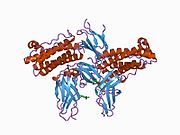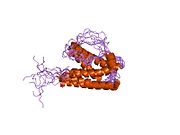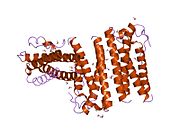Not to be confused with granulocyte-macrophage colony-stimulating factor.
Granulocyte colony-stimulating factor (G-CSF or GCSF), also known as colony-stimulating factor 3 (CSF 3), is a glycoprotein that stimulates the bone marrow to produce granulocytes and stem cells and release them into the bloodstream.
Functionally, it is a cytokine and hormone, a type of colony-stimulating factor, and is produced by a number of different tissues. The pharmaceutical analogs of naturally occurring G-CSF are called filgrastim and lenograstim.
G-CSF also stimulates the survival, proliferation, differentiation, and function of neutrophil precursors and mature neutrophils.
Biological function
G-CSF is produced by endothelium, macrophages, and a number of other immune cells. The natural human glycoprotein exists in two forms, a 174- and 177-amino-acid-long protein of molecular weight 19,600 grams per mole. The more-abundant and more-active 174-amino acid form has been used in the development of pharmaceutical products by recombinant DNA (rDNA) technology.
- White blood cells
- The G-CSF-receptor is present on precursor cells in the bone marrow, and, in response to stimulation by G-CSF, initiates proliferation and differentiation into mature granulocytes. G-CSF stimulates the survival, proliferation, differentiation, and function of neutrophil precursors and mature neutrophils. G-CSF regulates them using Janus kinase (JAK)/signal transducer and activator of transcription (STAT) and Ras/mitogen-activated protein kinase (MAPK) and phosphatidylinositol 3-kinase (PI3K)/protein kinase B (Akt) signal transduction pathway.
- Hematopoietic System
- G-CSF is also a potent inducer of hematopoietic stem cell (HSC) mobilization from the bone marrow into the bloodstream, although it has been shown that it does not directly affect the hematopoietic progenitors that are mobilized.
- Neurons
- G-CSF can also act on neuronal cells as a neurotrophic factor. Indeed, its receptor is expressed by neurons in the brain and spinal cord. The action of G-CSF in the central nervous system is to induce neurogenesis, to increase the neuroplasticity and to counteract apoptosis. These properties are currently under investigations for the development of treatments of neurological diseases such as cerebral ischemia.
Genetics
The gene for G-CSF is located on chromosome 17, locus q11.2-q12. Nagata et al. found that the GCSF gene has four introns, and that two different polypeptides are synthesized from the same gene by differential splicing of mRNA.
The two polypeptides differ by the presence or absence of three amino acids. Expression studies indicate that both have authentic GCSF activity.
It is thought that stability of the G-CSF mRNA is regulated by an RNA element called the G-CSF factor stem-loop destabilising element.
Medical use
Chemotherapy-induced neutropenia
Chemotherapy can cause myelosuppression and unacceptably low levels of white blood cells (leukopenia), making patients susceptible to infections and sepsis. G-CSF stimulates the production of granulocytes, a type of white blood cell. In oncology and hematology, a recombinant form of G-CSF is used with certain cancer patients to accelerate recovery and reduce mortality from neutropenia after chemotherapy, allowing higher-intensity treatment regimens. It is administered to oncology patients via subcutaneous or intravenous routes. A QSP model of neutrophil production and a PK/PD model of a cytotoxic chemotherapeutic drug (Zalypsis) have been developed to optimize the use of G-CSF in chemotherapy regimens with the aim to prevent mild-neutropenia.
G-CSF was first trialled as a therapy for neutropenia induced by chemotherapy in 1988. The treatment was well tolerated and a dose-dependent rise in circulating neutrophils was noted.
A study in mice has shown that G-CSF may decrease bone mineral density.
G-CSF administration has been shown to attenuate the telomere loss associated with chemotherapy.
Use in drug-induced neutropenia
Neutropenia can be a severe side effect of clozapine, an antipsychotic medication in the treatment of schizophrenia. G-CSF can restore neutrophil count. Following a return to baseline after stopping the drug, it may sometimes be safely rechallenged with the added use of G-CSF.
Before blood donation
G-CSF is also used to increase the number of hematopoietic stem cells in the blood of the donor before collection by leukapheresis for use in hematopoietic stem cell transplantation. For this purpose, G-CSF appears to be safe in pregnancy during implantation as well as during the second and third trimesters. Breastfeeding should be withheld for three days after CSF administration to allow for clearance of it from the milk. People who have been administered colony-stimulating factors do not have a higher risk of leukemia than people who have not.
Stem cell transplants
G-CSF may also be given to the receiver in hematopoietic stem cell transplantation, to compensate for conditioning regimens.
Side effect
The skin disease Sweet's syndrome is a known side effect of using this drug.
History
Mouse granulocyte-colony stimulating factor (G-CSF) was first recognised and purified in Walter and Eliza Hall Institute, Australia in 1983, and the human form was cloned by groups from Japan and Germany/United States in 1986.
The FDA approved the first biosimilar of Neulasta in June 2018. It is made by Mylan and sold as Fulphila.
Pharmaceutical variants
The recombinant human G-CSF (rhG-CSF) synthesised in an E. coli expression system is called filgrastim. The structure of filgrastim differs slightly from the structure of the natural glycoprotein. Most published studies have used filgrastim.
Filgrastim was first marketed by Amgen with the brand name Neupogen. Several bio-generic versions are now also available in markets such as Europe and Australia. Filgrastim (Neupogen) and PEG-filgrastim (Neulasta) are two commercially available forms of rhG-CSF. The PEG (polyethylene glycol) form has a much longer half-life, reducing the necessity of daily injections.
Another form of rhG-CSF called lenograstim is synthesised in Chinese hamster ovary cells (CHO cells). As this is a mammalian cell expression system, lenograstim is indistinguishable from the 174-amino acid natural human G-CSF. No clinical or therapeutic consequences of the differences between filgrastim and lenograstim have yet been identified, but there are no formal comparative studies.
Research
G-CSF when given early after exposure to radiation may improve white blood cell counts, and is stockpiled for use in radiation incidents.
Mesoblast planned in 2004 to use G-CSF to treat heart degeneration by injecting it into the blood-stream, plus SDF (stromal cell-derived factor) directly to the heart.
G-CSF has been shown to reduce inflammation, reduce amyloid beta burden, and reverse cognitive impairment in a mouse model of Alzheimer's disease.
Due to its neuroprotective properties, G-CSF is currently under investigation for cerebral ischemia in a clinical phase IIb and several clinical pilot studies are published for other neurological disease such as amyotrophic lateral sclerosis A combination of human G-CSF and cord blood cells has been shown to reduce impairment from chronic traumatic brain injury in rats.
See also
References
- ^ GRCh38: Ensembl release 89: ENSG00000108342 – Ensembl, May 2017
- ^ GRCm38: Ensembl release 89: ENSMUSG00000038067 – Ensembl, May 2017
- "Human PubMed Reference:". National Center for Biotechnology Information, U.S. National Library of Medicine.
- "Mouse PubMed Reference:". National Center for Biotechnology Information, U.S. National Library of Medicine.
- Deotare U, Al-Dawsari G, Couban S, Lipton JH (September 2015). "G-CSF-primed bone marrow as a source of stem cells for allografting: revisiting the concept". Bone Marrow Transplantation. 50 (9): 1150–1156. doi:10.1038/bmt.2015.80. PMID 25915812. S2CID 20774089.
- Tay J, Levesque JP, Winkler IG (February 2017). "Cellular players of hematopoietic stem cell mobilization in the bone marrow niche". International Journal of Hematology. 105 (2): 129–140. doi:10.1007/s12185-016-2162-4. PMID 27943116.
- Thomas J, Liu F, Link DC (May 2002). "Mechanisms of mobilization of hematopoietic progenitors with granulocyte colony-stimulating factor". Current Opinion in Hematology. 9 (3): 183–189. doi:10.1097/00062752-200205000-00002. PMID 11953662. S2CID 5774130.
- Schneider A, Krüger C, Steigleder T, Weber D, Pitzer C, Laage R, et al. (August 2005). "The hematopoietic factor G-CSF is a neuronal ligand that counteracts programmed cell death and drives neurogenesis". The Journal of Clinical Investigation. 115 (8): 2083–2098. doi:10.1172/JCI23559. PMC 1172228. PMID 16007267.
- Pitzer C, Krüger C, Plaas C, Kirsch F, Dittgen T, Müller R, et al. (December 2008). "Granulocyte-colony stimulating factor improves outcome in a mouse model of amyotrophic lateral sclerosis". Brain. 131 (Pt 12): 3335–3347. doi:10.1093/brain/awn243. PMC 2639207. PMID 18835867.
- ^ Nagata S, Tsuchiya M, Asano S, Kaziro Y, Yamazaki T, Yamamoto O, et al. (1986). "Molecular cloning and expression of cDNA for human granulocyte colony-stimulating factor". Nature. 319 (6052): 415–418. Bibcode:1986Natur.319..415N. doi:10.1038/319415a0. PMID 3484805. S2CID 4325026.
- Lyman GH, Dale DC, Culakova E, Poniewierski MS, Wolff DA, Kuderer NM, et al. (October 2013). "The impact of the granulocyte colony-stimulating factor on chemotherapy dose intensity and cancer survival: a systematic review and meta-analysis of randomized controlled trials". Annals of Oncology. 24 (10): 2475–2484. doi:10.1093/annonc/mdt226. PMC 3841419. PMID 23788754.
- "Granulocyte colony stimulating factor (G-CSF)". Cancer Research UK. Retrieved 12 November 2014.
- Craig M, Humphries AR, Nekka F, Bélair J, Li J, Mackey MC (November 2015). "Neutrophil dynamics during concurrent chemotherapy and G-CSF administration: Mathematical modelling guides dose optimisation to minimise neutropenia". Journal of Theoretical Biology. 385: 77–89. Bibcode:2015JThBi.385...77C. doi:10.1016/j.jtbi.2015.08.015. PMID 26343861.
- Morstyn G, Campbell L, Souza LM, Alton NK, Keech J, Green M, et al. (March 1988). "Effect of granulocyte colony stimulating factor on neutropenia induced by cytotoxic chemotherapy". Lancet. 1 (8587): 667–672. doi:10.1016/S0140-6736(88)91475-4. PMID 2895212. S2CID 21255495.
- Hirbe AC, Uluçkan O, Morgan EA, Eagleton MC, Prior JL, Piwnica-Worms D, et al. (April 2007). "Granulocyte colony-stimulating factor enhances bone tumor growth in mice in an osteoclast-dependent manner". Blood. 109 (8): 3424–3431. doi:10.1182/blood-2006-09-048686. PMC 1852257. PMID 17192391.
- ^ Szyper-Kravitz M, Uziel O, Shapiro H, Radnay J, Katz T, Rowe JM, et al. (January 2003). "Granulocyte colony-stimulating factor administration upregulates telomerase activity in CD34+ haematopoietic cells and may prevent telomere attrition after chemotherapy". British Journal of Haematology. 120 (2): 329–336. doi:10.1046/j.1365-2141.2003.04043.x. PMID 12542495. S2CID 5785335.
- Myles N, Myles H, Clark SR, Bird R, Siskind D (October 2017). "Use of granulocyte-colony stimulating factor to prevent recurrent clozapine-induced neutropenia on drug rechallenge: A systematic review of the literature and clinical recommendations". The Australian and New Zealand Journal of Psychiatry. 51 (10): 980–989. doi:10.1177/0004867417720516. PMID 28747065.
- Lally J, Malik S, Krivoy A, Whiskey E, Taylor DM, Gaughran FP, et al. (October 2017). "The Use of Granulocyte Colony-Stimulating Factor in Clozapine Rechallenge: A Systematic Review". Journal of Clinical Psychopharmacology. 37 (5): 600–604. doi:10.1097/JCP.0000000000000767. PMID 28817489. S2CID 41269943.
- ^ Pessach I, Shimoni A, Nagler A (2013). "Granulocyte-colony stimulating factor for hematopoietic stem cell donation from healthy female donors during pregnancy and lactation: what do we know?". Human Reproduction Update. 19 (3): 259–267. doi:10.1093/humupd/dms053. PMID 23287427.
- Paydaş S, Sahin B, Seyrek E, Soylu M, Gonlusen G, Acar A, et al. (September 1993). "Sweet's syndrome associated with G-CSF". British Journal of Haematology. 85 (1): 191–192. doi:10.1111/j.1365-2141.1993.tb08668.x. PMID 7504506. S2CID 414133.
- Metcalf D (July 1985). "The granulocyte-macrophage colony-stimulating factors". Science. 229 (4708): 16–22. Bibcode:1985Sci...229...16M. doi:10.1126/science.2990035. PMID 2990035. S2CID 45170361.
- Souza LM, Boone TC, Gabrilove J, Lai PH, Zsebo KM, Murdock DC, et al. (April 1986). "Recombinant human granulocyte colony-stimulating factor: effects on normal and leukemic myeloid cells". Science. 232 (4746): 61–65. Bibcode:1986Sci...232...61S. doi:10.1126/science.2420009. PMID 2420009.
- Office of the Commissioner (2019-09-11). "Press Announcements - FDA approves first biosimilar to Neulasta to help reduce the risk of infection during cancer treatment". www.fda.gov.
- Weisdorf D, Chao N, Waselenko JK, Dainiak N, Armitage JO, McNiece I, et al. (June 2006). "Acute radiation injury: contingency planning for triage, supportive care, and transplantation". Biology of Blood and Marrow Transplantation. 12 (6): 672–682. doi:10.1016/j.bbmt.2006.02.006. PMID 16737941.
- Weinstock DM, Case C, Bader JL, Chao NJ, Coleman CN, Hatchett RJ, et al. (June 2008). "Radiologic and nuclear events: contingency planning for hematologists/oncologists". Blood. 111 (12): 5440–5445. doi:10.1182/blood-2008-01-134817. PMC 2424146. PMID 18287516.
- Finkel E (2005). Stem cells: controversy on the frontiers of science. Crows Nest: ABC Books. ISBN 978-0-7333-1248-9.
- Sanchez-Ramos J, Song S, Sava V, Catlow B, Lin X, Mori T, et al. (September 2009). "Granulocyte colony stimulating factor decreases brain amyloid burden and reverses cognitive impairment in Alzheimer's mice". Neuroscience. 163 (1): 55–72. doi:10.1016/j.neuroscience.2009.05.071. PMC 5966834. PMID 19500657.
- "AXIS 2: AX200 for the Treatment of Ischemic Stroke - Full Text View - ClinicalTrials.gov". clinicaltrials.gov.
- Zhang Y, Wang L, Fu Y, Song H, Zhao H, Deng M, et al. (2009). "Preliminary investigation of effect of granulocyte colony stimulating factor on amyotrophic lateral sclerosis". Amyotrophic Lateral Sclerosis. 10 (5–6): 430–431. doi:10.3109/17482960802588059. PMID 19922135. S2CID 43087598.
- Acosta SA, Tajiri N, Shinozuka K, Ishikawa H, Sanberg PR, Sanchez-Ramos J, et al. (2014). "Combination therapy of human umbilical cord blood cells and granulocyte colony stimulating factor reduces histopathological and motor impairments in an experimental model of chronic traumatic brain injury". PLOS ONE. 9 (3): e90953. Bibcode:2014PLoSO...990953A. doi:10.1371/journal.pone.0090953. PMC 3951247. PMID 24621603.
Further reading
- Duarte RF, Frank DA (June 2002). "The synergy between stem cell factor (SCF) and granulocyte colony-stimulating factor (G-CSF): molecular basis and clinical relevance". Leukemia & Lymphoma. 43 (6): 1179–1187. doi:10.1080/10428190290026231. PMID 12152985. S2CID 45748453.
- Mroczko B, Szmitkowski M (2005). "Hematopoietic cytokines as tumor markers". Clinical Chemistry and Laboratory Medicine. 42 (12): 1347–1354. doi:10.1515/CCLM.2004.253. PMID 15576295. S2CID 11414705.
- Sallerfors B, Olofsson T (October 1992). "Granulocyte-macrophage colony-stimulating factor (GM-CSF) and granulocyte colony-stimulating factor (G-CSF) secretion by adherent monocytes measured by quantitative immunoassays". European Journal of Haematology. 49 (4): 199–207. doi:10.1111/j.1600-0609.1992.tb00047.x. PMID 1281454. S2CID 35573524.
- Zink T, Ross A, Ambrosius D, Rudolph R, Holak TA (December 1992). "Secondary structure of human granulocyte colony-stimulating factor derived from NMR spectroscopy". FEBS Letters. 314 (3): 435–439. Bibcode:1992FEBSL.314..435Z. doi:10.1016/0014-5793(92)81521-M. PMID 1281794. S2CID 28422738.
- Kubota N, Orita T, Hattori K, Oh-eda M, Ochi N, Yamazaki T (March 1990). "Structural characterization of natural and recombinant human granulocyte colony-stimulating factors". Journal of Biochemistry. 107 (3): 486–492. doi:10.1093/oxfordjournals.jbchem.a123072. PMID 1692828.
- Nagata S, Tsuchiya M, Asano S, Yamamoto O, Hirata Y, Kubota N, et al. (March 1986). "The chromosomal gene structure and two mRNAs for human granulocyte colony-stimulating factor". The EMBO Journal. 5 (3): 575–581. doi:10.1002/j.1460-2075.1986.tb04249.x. PMC 1166801. PMID 2423327.
- Simmers RN, Smith J, Shannon MF, Wong G, Lopez AF, Baker E, et al. (February 1988). "Localization of the human G-CSF gene to the region of a breakpoint in the translocation typical of acute promyelocytic leukemia". Human Genetics. 78 (2): 134–136. doi:10.1007/BF00278182. PMID 2448221. S2CID 469736.
- Tweardy DJ, Cannizzaro LA, Palumbo AP, Shane S, Huebner K, Vantuinen P, et al. (August 1987). "Molecular cloning and characterization of a cDNA for human granulocyte colony-stimulating factor (G-CSF) from a glioblastoma multiforme cell line and localization of the G-CSF gene to chromosome band 17q21". Oncogene Research. 1 (3): 209–220. PMID 2453015.
- Tsuchiya M, Nomura H, Asano S, Kaziro Y, Nagata S (March 1987). "Characterization of recombinant human granulocyte-colony-stimulating factor produced in mouse cells". The EMBO Journal. 6 (3): 611–616. doi:10.1002/j.1460-2075.1987.tb04798.x. PMC 553441. PMID 3034599.
- Devlin JJ, Devlin PE, Myambo K, Lilly MB, Rado TA, Warren MK (April 1987). "Expression of granulocyte colony-stimulating factor by human cell lines". Journal of Leukocyte Biology. 41 (4): 302–306. doi:10.1002/jlb.41.4.302. PMID 3494801. S2CID 26877622.
- Kanda N, Fukushige S, Murotsu T, Yoshida MC, Tsuchiya M, Asano S, et al. (November 1987). "Human gene coding for granulocyte-colony stimulating factor is assigned to the q21-q22 region of chromosome 17". Somatic Cell and Molecular Genetics. 13 (6): 679–684. doi:10.1007/BF01534488. PMID 3499671. S2CID 10909775.
- Le Beau MM, Lemons RS, Carrino JJ, Pettenati MJ, Souza LM, Diaz MO, et al. (December 1987). "Chromosomal localization of the human G-CSF gene to 17q11 proximal to the breakpoint of the t(15;17) in acute promyelocytic leukemia". Leukemia. 1 (12): 795–799. PMID 3501046.
- Zink T, Ross A, Lüers K, Cieslar C, Rudolph R, Holak TA (July 1994). "Structure and dynamics of the human granulocyte colony-stimulating factor determined by NMR spectroscopy. Loop mobility in a four-helix-bundle protein". Biochemistry. 33 (28): 8453–8463. doi:10.1021/bi00194a009. PMID 7518249.
- Corcione A, Baldi L, Zupo S, Dono M, Rinaldi GB, Roncella S, et al. (October 1994). "Spontaneous production of granulocyte colony-stimulating factor in vitro by human B-lineage lymphocytes is a distinctive marker of germinal center cells". Journal of Immunology. 153 (7): 2868–2877. doi:10.4049/jimmunol.153.7.2868. PMID 7522243. S2CID 25302361.
- Watari K, Ozawa K, Tajika K, Tojo A, Tani K, Kamachi S, et al. (July 1994). "Production of human granulocyte colony stimulating factor by various kinds of stromal cells in vitro detected by enzyme immunoassay and in situ hybridization". Stem Cells. 12 (4): 416–423. doi:10.1002/stem.5530120409. PMID 7524894. S2CID 22671177.
- Hill CP, Osslund TD, Eisenberg D (June 1993). "The structure of granulocyte-colony-stimulating factor and its relationship to other growth factors". Proceedings of the National Academy of Sciences of the United States of America. 90 (11): 5167–5171. Bibcode:1993PNAS...90.5167H. doi:10.1073/pnas.90.11.5167. PMC 46676. PMID 7685117.
- Haniu M, Horan T, Arakawa T, Le J, Katta V, Rohde MF (December 1995). "Extracellular domain of granulocyte-colony stimulating factor receptor. Interaction with its ligand and identification of a domain in close proximity of ligand-binding region". Archives of Biochemistry and Biophysics. 324 (2): 344–356. doi:10.1006/abbi.1995.0047. PMID 8554326.
- McCracken S, Layton JE, Shorter SC, Starkey PM, Barlow DH, Mardon HJ (May 1996). "Expression of granulocyte-colony stimulating factor and its receptor is regulated during the development of the human placenta". The Journal of Endocrinology. 149 (2): 249–258. doi:10.1677/joe.0.1490249. PMID 8708536.
External links
- Granulocyte+Colony-Stimulating+Factor at the U.S. National Library of Medicine Medical Subject Headings (MeSH)
- Overview of all the structural information available in the PDB for UniProt: P09919 (Granulocyte colony-stimulating factor) at the PDBe-KB.
| PDB gallery | |
|---|---|
|
| Colony-stimulating factors | |
|---|---|
| CFU-GEMM | |
| CFU-GM | |
| CFU-E | |
| CFU-Meg | |
| Immunostimulants (L03) | |||||||||||||
|---|---|---|---|---|---|---|---|---|---|---|---|---|---|
| Endogenous |
| ||||||||||||
| Exogenous | |||||||||||||
| Cytokine receptor modulators | |||||||||||||
|---|---|---|---|---|---|---|---|---|---|---|---|---|---|
| Chemokine |
| ||||||||||||
| CSF |
| ||||||||||||
| Interferon |
| ||||||||||||
| Interleukin |
| ||||||||||||
| TGFβ |
| ||||||||||||
| TNF |
| ||||||||||||
| Others |
| ||||||||||||










